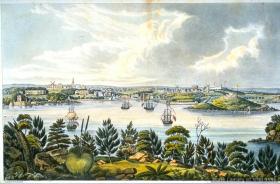Sydney: a story of change
Students compare and contrast historic and modern images to identify and explain how their community has changed and continued over time.
Student Activities
Sydney: a story of change
Students use photos and paintings from the collections of the State Library to identify the main features of the cultural landscape of Sydney and describe how Sydney has changed over time.

NSW Syllabus for the Australian Curriculum History K-10
HT1-2 identifies and describes significant people, events, places and sites in the local community over time
HT1-4 demonstrates skills of historical inquiry and communication
One important example of change over time in the local community, region or state/territory, e.g. transport, work, education, natural and built environment, daily life (ACHHK061)
The history of a significant person, building, site or part of the natural environment in the local community and what it reveals about the past (ACHHK044)
Students:
- brainstorm what aspects of the past can be seen in the local area
- identify a significant building, site or part of the natural environment in the local community and discuss what they reveal about the past and why they are considered important
- investigate an aspect of local history
- develop a narrative on their chosen aspect of local history which focuses on the remains of the past
Students:
Comprehension: chronology, terms and concepts
- use historical terms (ACHHS065, ACHHS082)
Analysis and use of sources
- locate relevant information from sources provided (ACHHS068, ACHHS084, ACHHS215, ACHHS216)
Research
- pose a range of questions about the past (ACHHS067, ACHHS083)
Explanation and communication
- develop texts, particularly narratives (ACHHS070, ACHHS086)
- use a range of communication forms (oral, graphic, written) and digital technologies (ACHHS071, ACHHS087)
Continuity and change: some things change over time and some things remain the same
Cause and effect: events, decisions or developments in the past that produce later actions, results or effects
Learning across the curriculum
- Literacy
- Work and enterprise
- Sustainability
How has our community changed? What features have been lost and what features have been retained?
Background notes
It is difficult to understand now, but a long time ago the city we know as Sydney did not exist. The Cadigal People were the first people to live around the harbour where Sydney now exists. The earliest European painting of ‘Cadi’ (the Aboriginal word for Sydney Cove) in 1788 by the Port Jackson Painter shows a beautiful, thick bush and rock landscape that continued right down to the water’s edge. With the arrival of the First Fleet in January 1788 the entire landscape was changed forever as the convicts and marines chopped down trees and built huts, houses and government buildings around the harbour.
The simple bark huts built by the convicts were soon replaced by brick buildings; wharves were built for the big sailing ships that docked in the harbour and they were replaced by the ferries of Circular Quay; dirt tracks for carts and carriages eventually developed into paved roads and highways.
Today we are surrounded by enormous structures that seem to have always been there. We take for granted that the city of Sydney has massive skyscrapers, the Harbour Bridge and the Opera House. Today we can drive across the harbour in a few minutes on the Harbour Bridge, but until 1932 people had to travel across the harbour by row boat or ferry.
Let’s look at the city of Sydney as it has changed over time. Can you imagine what it might look like 200 years from now?